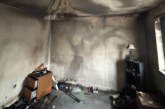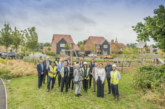Ensuring the safety of tenants has always been a paramount concern for social housing providers. Now, with new legislation for landlords in place mandating the provision of CO and smoke alarms, Martin Wilson, Sales Director at Resideo, looks at what this means for the sector across both new and existing properties, and the options available to meet this demand.
The Department for Levelling Up, Housing and Communities (DLUHC) has taken a renewed approach to smoke and carbon monoxide alarms by mandating that new build developers, particularly those within the social housing sector, ensure that the right alarms are fitted in new and existing properties.
The recommendations for social housing in England and Wales included in The Smoke and Carbon Monoxide Alarm (Amendment) Regulations 2022: guidance for local authorities, are in force from 1st October 2022. It aims to extend existing private rented legislation to socially rented properties, as well as making improvements to existing legislation.
For fire safety, the guidance for England and Wales requires at least one smoke alarm to be installed on each storey of a property, to help alert tenants to domestic fires more quickly, ensuring a quicker evacuation and reduced risk of fatality. In addition, in both privately rented houses and social housing, carbon monoxide alarms are now mandatory in rooms with any fixed combustion appliance (excluding gas cookers).
In Scotland, legislation that came in February 2022 is arguably more stringent than in England and Wales. Not only is it mandated that carbon monoxide alarms are installed in any room with fixed combustion appliances (excluding gas cookers), but also that every home has one smoke alarm in the most used room in the house, a smoke alarm in every hallway or landing and a heat alarm in the kitchen. Additionally, these smoke and heat alarms should be interconnected (or ‘interlinked’), so when one alarm goes off, they all go off, alerting people wherever they are in a house.
These regulations now form the minimum standard for safe houses, and local authorities will be able to use their statutory powers to ensure these are met.
CO alarms in action
As one of the largest social housing providers in the UK, Nottingham City Homes (NCH) had a significant challenge to meet the new regulations easily and in a timely manner, whilst ensuring that tenant safety wasn’t compromised. With a mission to create homes and places where people want to live, NCH places resident safety at the top of its list of priorities.
Fixed combustion appliances, such as space heaters, fireplaces, water heaters, and clothes dryers are often powered by fuels such as oil, kerosene, wood, and coal or liquefied petroleum gas (LPG). All have the potential to cause carbon monoxide (CO) poisoning in the home, with children, the elderly, and pets are particularly vulnerable, but installing a CO alarm, alongside fuel-burning appliances can significantly lower that risk.
CO has a slightly lower density than air, and therefore tends to accumulate near the ceiling, so it is recommended that any CO alarms be placed on the ceiling, or at least five feet above the floor. As such, ease of installation remains key to avoid unnecessary disruption to tenants’ homes.
By tapping into the expertise of Resideo, a leading global provider of home, air, water, security and energy products and solutions, Nottingham City Homes was able to successfully roll out a solution that would meet the new regulations coming into force. As a result, over 24,500 CO alarms will be installed in homes managed by NCH.

Overcoming challenges
A key challenge of the project was that the solution had to be suitable for all tenants, particularly those with hearing impairments. From the outset, Resideo’s team of experts was on-hand with the product knowledge and supported NCH in finding the right solution and concluded that Resideo’s wireless Honeywell Home R100C-1 would be ideal.
The alarm offers a visible built-in flashing alarm system on the front of the unit, making it advantageous for elderly tenants and those who are hard of hearing. Fitted with a high-precision sensor, the alarm sends out a signal as soon as dangerous levels of CO are identified in the room. A red ‘ALARM’ text will flash up on the alarm when it sounds and remains on until it is dealt with. As a result, if it is activated whilst the tenants are away from the property, when they return they will be alerted to an incident immediately.
A second challenge was to be able to retrofit, easily and with minimum disruption to homes. The lightweight design combined ease of fit with additional end user benefits, including a low-power chip to ensure they last for 10 years in standby mode.
Steve Cooper, Head of Mechanical and Electrical at NCH, says: “Tenant safety is our number one priority here at Nottingham City Homes, which is why we made the decision to begin our CO alarm installation programme earlier this year. The programme meant our team of engineers were installing around 500 units each week, so we were looking for a product that was quick, lightweight and could be added to properties without hassle or delay.
“The R100C-1 not only looked good, but the flat back of the product made it particularly simple to fit. We also had the extra peace of mind that it came from a manufacturer that we knew we could trust to deliver the quality that matched our own objectives.”
In an ongoing programme, R100C-1 CO alarms are also being installed across all NCH properties with a gas appliance.
Steve concludes: “We’re always on the lookout for solutions that benefit tenants but also minimise disturbance to their home. Not only does the R100C-1 come with a 10-year battery life and warranty, but its slim design also enables our engineers to easily install the alarms, saving time and minimising disruption to our tenants.”
Smoke and heat
Whilst improved safety standards over time have greatly reduced the consequences of domestic fires; faulty wiring, unattended cooking and smoking remain the most common causes. In addition, modern fireproof household materials, appliances and furniture generate a lot less smoke than standard materials, which leads to smoke alarms taking longer to trigger.
Choosing a smoke alarm from a trusted manufacturer can help to secure customer trust and reduce callbacks after completion. For example, Resideo’s Honeywell Home R200S-1 (standalone) and the R200S-N1 (interconnected) smoke alarms come with a 10-year warranty with an automatic self-test.
Heat alarms also help warn of a potential domestic fire early on, as they detect an abnormal increase in temperature. Heat alarms are particularly useful in rooms where dust collects easily, or where smoke is often present during cooking — such as kitchens — where installing a smoke alarm may result in a false signal.
Providing several options, the Honeywell Home R200H-N1, for instance, is an interconnected heat alarm with an integrated thermal sensor and wireless interconnection with up to 12 devices. In addition, the Honeywell Home R200ST-N1 is an interconnected combined heat and smoke alarm, which will pre-warn tenants of an increase in temperature before detecting smoke, working well as an all-in-one solution for smaller dwellings such as flats or bedsits.
Resideo’s full range of Honeywell Home smoke, heat and CO alarms have been designed for suitability in all types of properties, with up to 12 devices being able to interlink at once.









